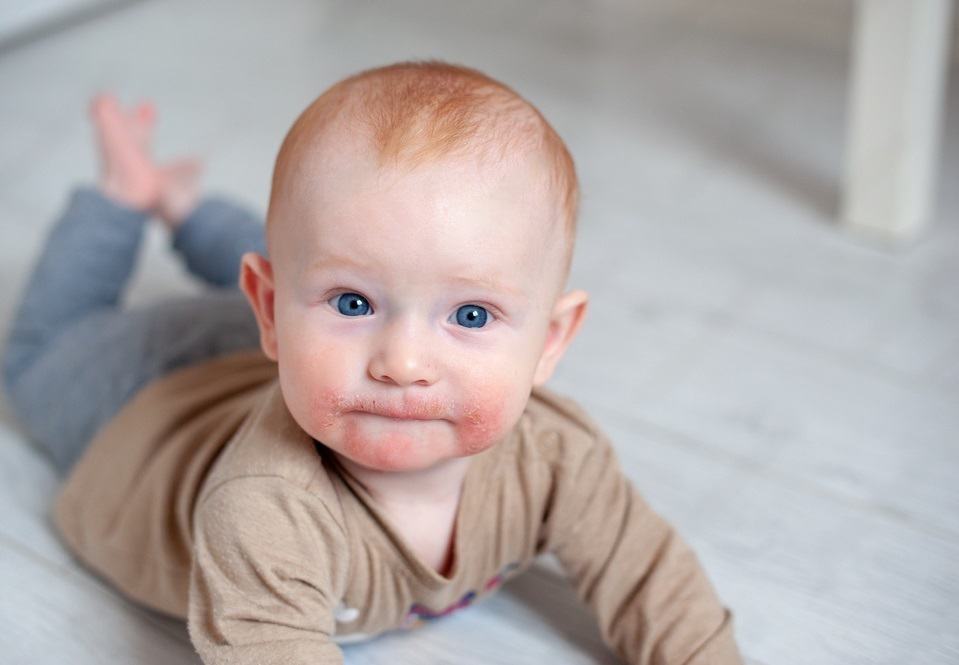
Table of Contents
Have you ever noticed your little one’s rosy cheeks or a mysterious red rash popping up around their mouth? If so, you might have wondered, “Can teething cause a rash?” It’s a common question many parents ask, and in this article, we’re going to explore this intriguing topic.
As babies start teething, they go through a range of changes that can sometimes lead to unexpected skin issues. Understanding the connection between teething and rashes can help you provide better care for your child during this developmental phase. So, let’s dive in and find out if those tiny teeth poking through can be the culprits behind those pesky rashes.
Check out: Top 10 Best Teething Toys for babies
Can Teething cause a Rash On Face: When Does It Happen?
When your baby is between 6 and 24 months old, those baby teeth start popping up in their gums. But along with those teeth, there’s often a lot more drooling, and all that wetness can bug your baby’s delicate skin, causing a rash. We call it teething rash or drool rash.
This rash happens because food, spit, and all that moisture can annoy your baby’s skin. Plus, when their skin rubs against things like clothes or during playtime, it can stick around for a bit, but it’s nothing to worry about.
How To Identify Teething Rash On Face Or Other Areas?
Sure, let’s break it down in a simpler way:
- Expect Lots of Drool: Your little one will probably drool a bunch in the first couple of years. This usually starts around 4 to 6 months when their first tooth is on the way. They can get a rash from all that drool, but it doesn’t mean their teeth are coming right away.
- Where the Rash Shows Up: This drool rash can pop up anywhere drool hangs out, like the chin, cheeks, neck, or chest. If they use a pacifier, you might see a rash where it touches their skin.
- What the Rash Looks Like: The teething rash is often flat or slightly raised, with red patches and tiny bumps. Sometimes, the skin can get a bit chapped. It might come and go for a few weeks.
- Other Teething Signs: Besides drool and the rash, watch for increased chewing on toys or things. They might also have gum pain, which can make them cry or fuss more.
- No Fever from Teething: Teething itself doesn’t cause a fever. If your baby has a fever or seems way fussier than usual, give your baby’s doctor a call. They can check things out and make sure everything’s okay.
So, teething can make your little one drool a lot and get a rash, but it won’t give them a fever. Keep an eye on them, and if you’re worried, talk to the doctor.
Can teething cause a rash and cold symptoms? Well, when babies reach around 6 months old, the protection they got from their mom starts to fade away. So, they might catch more germs around this time, which just happens to be when their little teeth are starting to come in.

When To Visit A Doctor?
Knowing when to seek medical advice for a teething rash is important. Can teething cause a rash? Sometimes, a drool rash can resemble measles or hand, foot, and mouth disease, but usually, those illnesses come with fevers and the baby looks sick.
To be sure it’s just a teething rash and not something else, it’s a good idea to contact your child’s doctor. Most rashes aren’t serious, but it’s better to be safe.
However, if you notice a rash with tiny red dots that don’t turn white when pressed, and your baby has a fever, that needs immediate medical attention. These dots are burst blood vessels called petechiae, and they require prompt medical care.
If your baby’s drool rash suddenly gets worse, looks cracked, starts bleeding, or is oozing fluid, it’s a good idea to visit the doctor. And if your little one is under 6 months old and has a fever along with these symptoms, definitely see the doctor. They’ll also check your baby’s teeth and gums during regular check-ups.
Any Home Remedies For Teething?
Certainly, here’s a simple way to deal with teething rash at home:
- Keep the rash clean and dry.
- Apply a healing balm to soothe the skin.
- You can use creams like Lansinoh lanolin, Aquaphor, or Vaseline to create a protective barrier against drool.
- Avoid using fragrant lotions on the rash.
- After drying the drool, apply the cream a few times a day. You can make it part of your routine during diaper changes.
- If the rash is really bad, consult your child’s doctor for more advice.
Remember, keeping it clean and using a gentle cream can help your baby feel better during teething. Can teething cause a rash? There’s a bit of a debate on whether teething hurts babies. If it does, it usually happens when the tooth is poking through the gums, and sometimes a few days before or after. To help your little one with both teething rash and tooth pain, here are some things you can try:
- Gently massage their sore gums with a clean finger for about two minutes.
- Use teething toys, but make sure to chill them in the fridge, not the freezer. You can find these toys online.
- If your baby is over 12 months, they might enjoy nibbling on chilled banana pieces or frozen peas. Just avoid hard foods like carrots since they can be a choking hazard.
- If your baby won’t breastfeed or take a bottle, try giving them milk in a cup.
- On occasion, you can give your baby a small dose of baby acetaminophen (like Tylenol) before bedtime if they seem extra uncomfortable. But don’t do this for more than a night or two, and make sure to follow the right dosage based on your weight. If your baby is consistently fussy and uncomfortable, it might not just be teething, so give the doctor a call.
Oh, and those teething gels? Not recommended. They often have unsafe stuff in them and only offer a little bit of temporary relief.
A Note For Our Readers
In conclusion, the answer to the question, “Can teething cause a rash?” is a bit more complex than a simple “yes” or “no.” While teething itself doesn’t directly cause a rash, the process of teething can lead to various symptoms, including drooling and chin or cheek irritation. These, in turn, can sometimes contribute to the development of a rash.
Remember, if you’re ever concerned about a rash or any other symptoms your child is experiencing during teething, it’s always a good idea to consult with a pediatrician or healthcare professional. They can provide guidance specific to your child’s needs and ensure your little one is happy and healthy as they continue to grow and develop.







